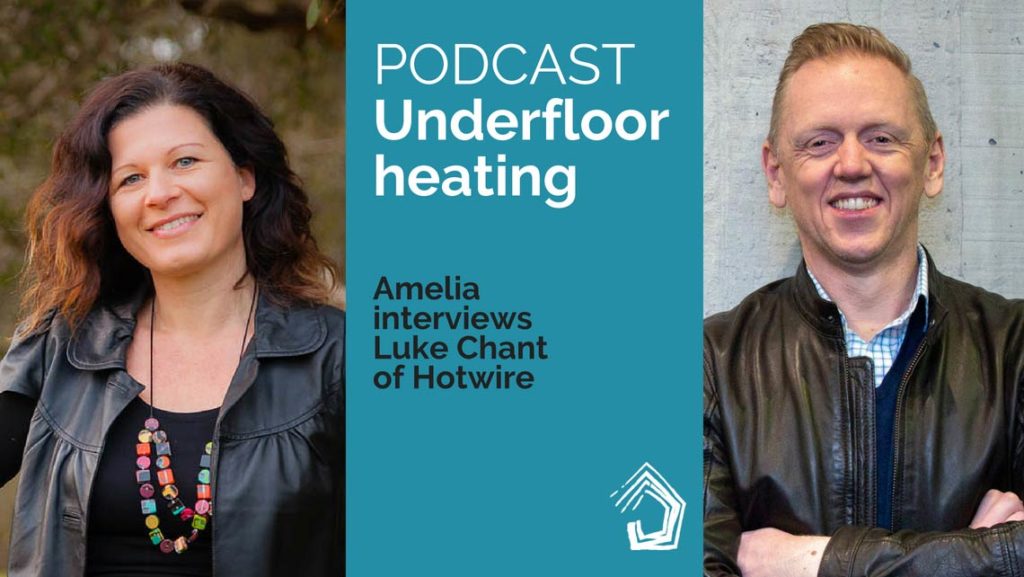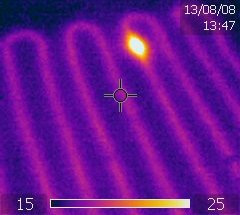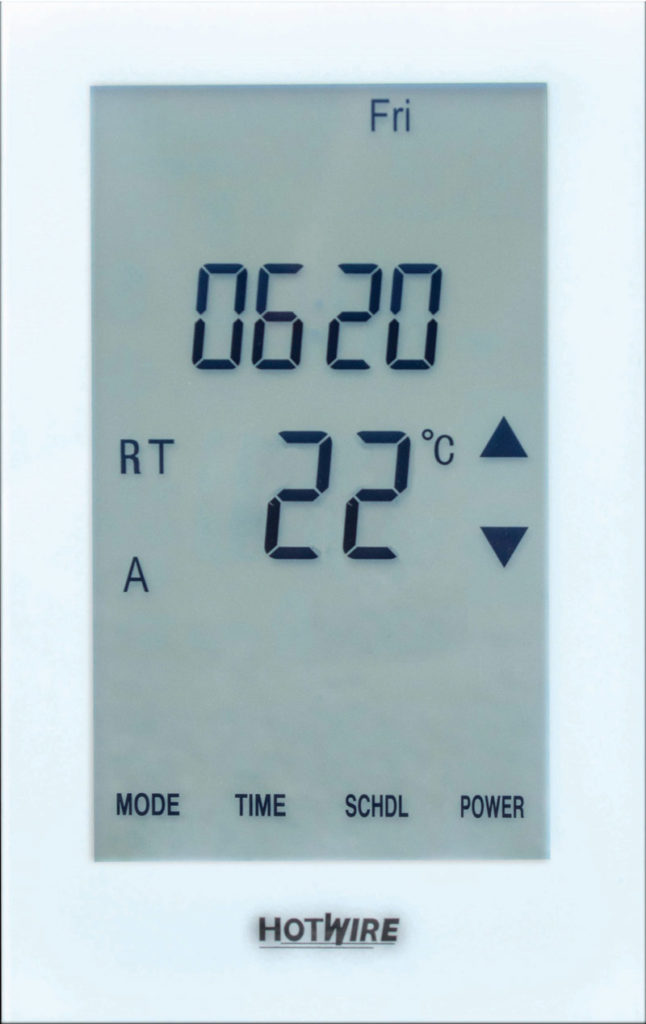
Want to learn about underfloor heating?
There’s still lots of confusion and misconceptions about how it works, where it can be installed and how to get the most from it – whether you’re building or renovating.
Here are some of the questions I asked Luke about underfloor heating:
- How does underfloor heating work? What are the elements under the floor? How is it powered?
- How much room does it need to fit under a finished floor?
- What are the electricity costs compared with something central heating?
- Does it always need to be under tiles or concrete to be thermally efficient … and mounted on a concrete slab? Or can it be used under timber floors, and on suspended structure and still be ok (or will you need to have it on all the time)?
- Is it worth it for future re-sale/electricity cuts to budget for under floor heating for the whole house?
- How much does it cost? For a standard bathroom or living room area?
- At what stage in your reno or build do you need to think about it? And when you need to have it locked down for installation?
- Is difficult to retrofit underfloor heating in a renovation? How does that work?
- What are the big mistakes people make when it comes to considering/installing underfloor heating?
- What tips can you give to customers looking for reputable products and installers? For example I just had a friend tell me on the weekend who’s done a reno in Sydney, and had drama after drama because the builder went bust mid-job … they’ve just discovered their underfloor heating which is driven by this big unit that then also heats the pool … the installer as gone bust as well … and they’ve discovered a bunch of parts in the unit are second hand … it’s never been able to be commissioned.
- What are things people assume about underfloor heating that they’re usually wrong about?
- Can underfloor heating damage or crack tiles?
- Are there any safety concerns to worry about with underfloor heating?
- Do you need another heating source to supplement underfloor heating?
You can watch this interview on video, or scroll down to play the podcast …
Underfloor heating is a topic of much interest in the UA Community. Previously seen as a luxury item only used in high-end homes, in recent years it’s become much more prevalent.
In this episode, I’m bringing in an expert … Luke Chant, from Hotwire, who has 15 years industry experience, to help shed some light on how to get it right when it comes to underfloor heating.
Luke and I met through a business networking group we’re part of. This is not sponsored content … it’s simply from talking with Luke, and seeing the reputation Hotwire has in the industry, and how many other brands trust them, that made me want to bring him to the UA Community – because I knew how helpful his knowledge would be for your projects.
As I said, Luke has 15 years industry experience in this area. His company, Hotwire, supplies the various components and gear to installers for underfloor heating, plus a range of other items you may want to check out. Hotwire is based in Melbourne, and they have installers throughout Australia that specify and use their products.

Photo of thermal imaging that shows issue with underfloor heating, as described by Luke Chant in the interview
Hotwire has been featured on, The Block, House Rules, Reno Rumble and The Home Team.
Hotwire is also the recommended floor heating (and/or) heated towel rail supplier for some of the biggest tile and electrical suppliers in the industry.

An example of the Hotwire thermostat screen, as described by Luke Chant in the interview
I asked Luke some of the most common questions I receive about underfloor heating … the different types, what type of floors you can put it under, how much it costs to install and run, retrofitting it to an existing home, and how to find a trustworthy supplier. He gives us loads of info on all of these questions – plus lots more.
Want the answers? Listen to the podcast now!
RESOURCES MENTIONED IN THIS PODCAST:
You can connect with Luke Chant and Hotwire here >>> https://www.hotwireheating.com.au/


 With over 30 years industry experience, Amelia Lee founded Undercover Architect in 2014 as an award-winning online resource to help and teach you how to get it right when designing, building or renovating your home. You are the key to unlocking what’s possible for your home. Undercover Architect is your secret ally
With over 30 years industry experience, Amelia Lee founded Undercover Architect in 2014 as an award-winning online resource to help and teach you how to get it right when designing, building or renovating your home. You are the key to unlocking what’s possible for your home. Undercover Architect is your secret ally
Hi, any chance there is a transcript? I can read 1000x faster than I listen 🙂
Hi Christina,
No, unfortunately not. You can install plugins on your computer that enable you to watch a video at faster speeds though if that helps!
– Amelia, UA
I think Luke is being a bit tricky when he talks about running costs.
At one point he compares it to heat lamps – typically you would only have the heat lamps on when you are in the bathroom while underfloor heating would typically run for several hours.
On his website (PDF catalogue) he has a running cost comparison which makes out that the underfloor heating is lots cheaper to run than heat lamps but that is based on running heat lamps for 3hrs/day – who in their right mind would do that?? They also use 375W heat lamps instead of the more common 275W ones. If you bring it down to 45mins of heat lamps using 275W bulbs then the heat lamps are 2/3 the running cost.
He also says the running cost can be as low as 2c/hr – based on a 600W element (the size they use for their pricing calc, for 3.3m2 bathroom I think) running at 50% duty cycle (ie 300W) you would need to be paying 6.6c/kWh for electricity for that to be true. Off peak electricity in Victoria seems to be around 20c/kWh so he must have a very small bathroom!!
I’m not saying it’s a dud product or idea but I think the “cheap to run” cost aspect is overblown.
Hey Peter – thanks for your comment. I’ll ask Luke to respond to your feedback.
– Amelia, UA
Hi Peter, Thanks for your response. I love that you have put so much thought into it.
To clarify on the running costs. It is not 2c an hour. It is 2c per m2 per hour. This is based on running at full capacity for 30 mins to reach the desired temp and then running at 50% capacity after that. Based on around 26-28c per Kilowatt this maths should be spot on.
With regard to heat lamp, I can certainly revisit my table based on the lower wattage bulbs that are now more common. I must confess to producing that some time ago. I have 3 teenage daughters so the lamps in my place would definitely be on for that long each day! You should see the number of towels in that bathroom! The heated towel rails get a work over too.
Hotwire and floor heating in general is quite inexpensive to buy and very cost effective to run. Particularly when you are talking about bathrooms. I do appreciate that not everyone has 3 teenage daughters though. 🙂
Thanks again for your comments and I would be more than happy to chat directly if you would like.
Thanks Luke for responding to Peter. Peter – hope that helps you, and feel free to get in touch with Luke if you need anything clarified further.
– Amelia, UA
Hi, just curious if you have any thoughts or recommendations on hydronic heating? We are finding that builders in the area we are building (JINDABYNE NSW) are going that way.
Cheers
Jo
Hi Jo,
This blog post / podcast interview only focussed on one type of underfloor heating. Hydronic heating is another alternative many homeowners choose and can be really effective, especially in cold locations. It is a decision that needs to be made early because it gets built in as part of slab construction.
– Amelia, UA
Just wondering what type of floating flooring is suitable to go over the top of hydronic heating?
Hi Ange,
It’s something to check with the manufacturers, as you’ll need to confirm their warranties will cover it. Sometimes it will involve limiting the temperature etc so the floating floor isn’t negatively impacted.
– Amelia, UA